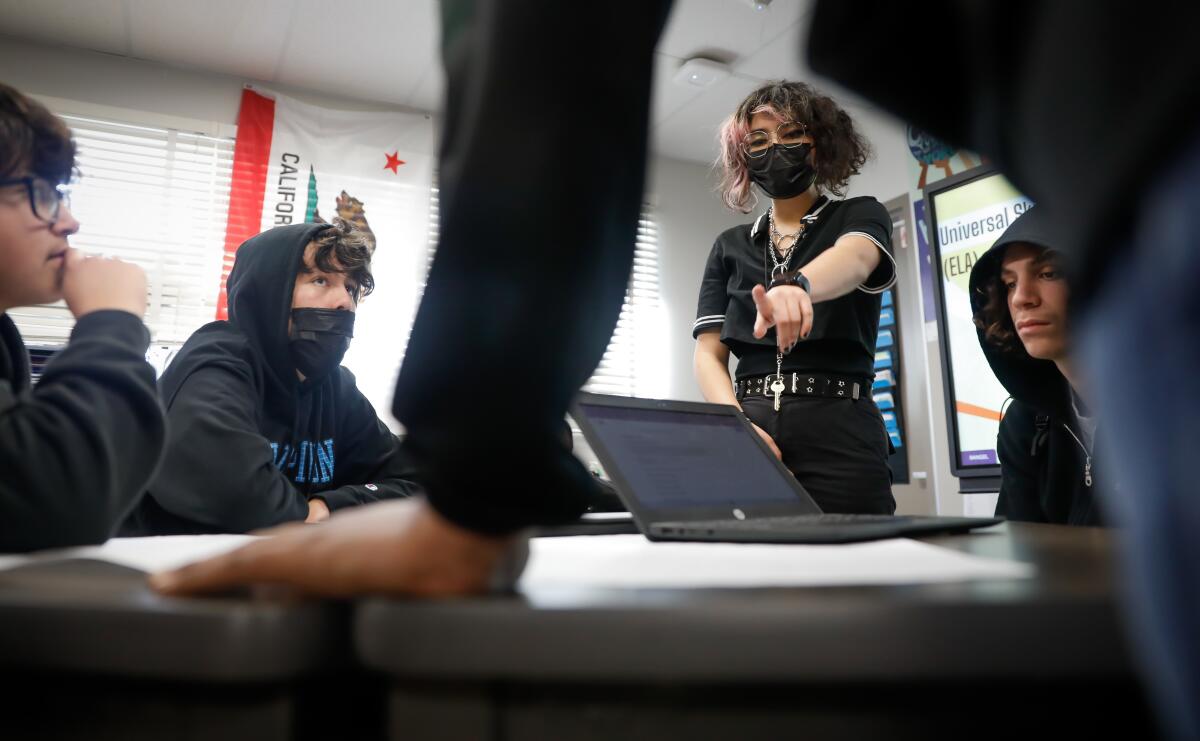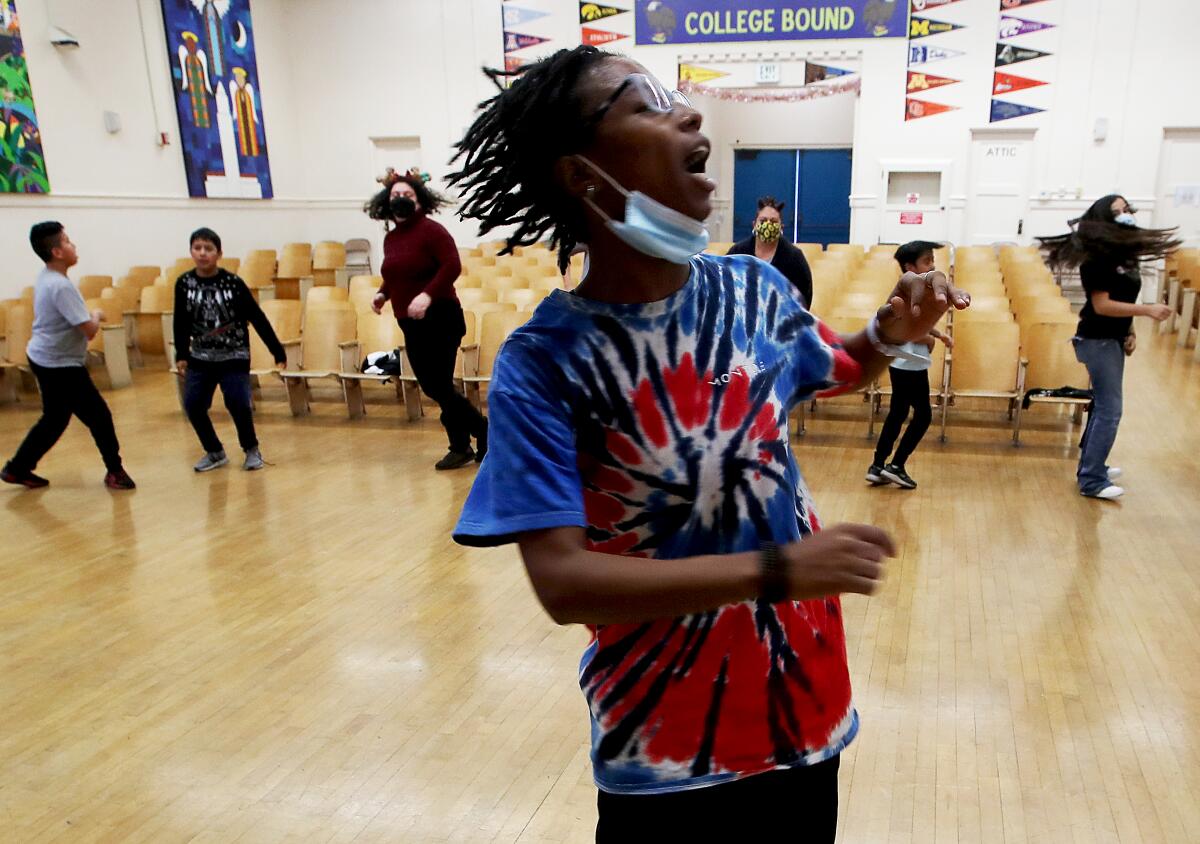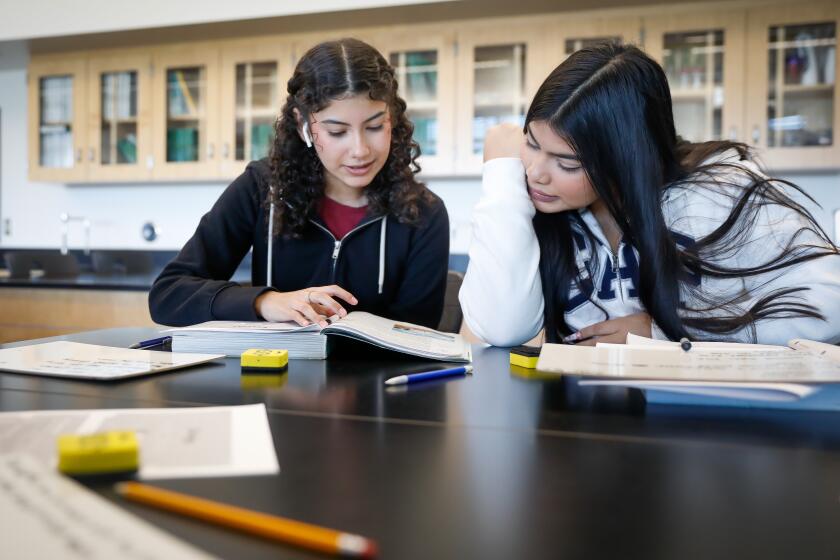L.A. students and their parents to get unique road map to improve academic weaknesses

- Share via
Los Angeles schools Supt. Alberto Carvalho has announced a plan to create a unique progress report for every student and also to bring in “late buses” so children can stay after school for tutoring and get a ride directly to their homes — efforts to improve learning and make up ground lost during the pandemic.
The proposed Individual Acceleration Plans, or IAPs, would affect all students in the nation’s second-largest school district and provide parents with a clear explanation of how their children are doing in school.
“This is a document which will live on the website that can be printed — easy to understand, written at a fifth-grade reading level — that parents will look at, students will see,” Carvalho said last week. “And they will be able to determine at this point in time where they are academically, in reading and mathematics, whatever it is.”
High school students will see at a glance if they are on track to graduate, Carvalho said. “But the beauty about this IAP is that there is a series of recommended actions.”
These would include steps such as signing up for tutoring, acceleration days and after-school programming and working online “at your own pace from home.” The reports also are to include activities and Parent Academy classes for parents to support their students.
The alarming dip in math proficiency and smaller declines in English in the last two pandemic-disrupted school years hit students who were already behind.
The exact content — which standardized test scores would be included, for example — is still in the design stage, officials said.
The late-bus idea would make in-person tutoring more accessible for students. It builds on a concept familiar to many in high school sports. Athletes often miss their bus ride home after practice or a game — and sometimes a late bus has been provided, although not necessarily with door-to-door service. And students with serious disabilities often receive transportation from home to school.
The idea of an individual education plan is rooted in what already is required under federal law for students with disabilities. Each of these students is supposed to receive an Individualized Education Program, or IEP, through an evaluation and meeting process that includes teachers, specialists and the parent. The IEP maps out what kind of special educational services the student needs.
The superintendent also previewed plans to ensure that all food-service workers have air-conditioned and heated work spaces within a year.

Carvalho said he also would speed up plans for greening campuses. Many — possibly the vast majority — are seas of asphalt.
That was welcome news to Heather Mura, principal at Alta Loma Elementary, an asphalt-intensive campus in Mid-City and one of Carvalho’s stops on Tuesday during the last of two optional academic “acceleration days” designed to give students extra learning time with a teacher at school.
Mura had a carefully planned day for students — each received math and English as well as enrichment activities, including a dance lesson from an instructor at a local dance school.
Carvalho said some 60,000 of about 72,000 registered students showed up Monday — figures that some teachers immediately challenged as inflated, based on low participation at their campuses, especially given technical problems with inputting attendance data.
While Carvalho acknowledged that there were significant glitches Monday in taking roll, he also said he believes the district’s numbers are reliable. The announced participation — about 1 in 7 students — surpassed his expectations, Carvalho added, given that the acceleration days took place during the first two days of winter vacation.
Additional acceleration days are scheduled for the first two weekdays of spring break. Officials have budgeted as much as $65 million for all four days. Debate continues over whether the acceleration days are cost-effective, reach enough students and meet their needs.
By the end of the week, the district had not provided attendance figures for Tuesday or updated figures for Monday.
Alta Loma has 396 students and also hosted students from four other local elementary schools, a pool of about 1,700 students. Of these, 179 registered for the acceleration days and 64 showed up, including six who hadn’t registered.
Officials said that, districtwide, 14% of students participated on the first day — a small percentage but still a lot of students in absolute terms.
Teachers reported attendance figures that were much lower — and lower still on the second day. Some teachers enjoyed the relaxed atmosphere and small groups. Others said the benefit wasn’t worth the cost.
Two extra learning days during winter break represented a compromise after the teachers union objected to an extended school year for academic recovery.
Parents also reported varying perspectives — ranging from high praise to complaints about glorified babysitting.
Teacher JoAnn Murray normally works at Columbus Middle School in Canoga Park but was at Nobel Middle School in Northridge for the acceleration days.
She said the principal had worked hard to organize the days to flow smoothly but many participating teachers had no information about their students in advance.
“The concept of addressing students’ specific deficits and challenges does not apply, as we don’t know the students or their areas of deficit,” she said. “There were two to three teachers assigned to each class, as, apparently, principals were instructed to hire every person who committed to coming. [On Monday] we had 119 students total and 88 staff members.”
Teachers and other staff were paid at their normal daily rates. Nobel’s enrollment is about 2,000 students.

Close to one-third of campuses were open for the acceleration days and several schools reported that it was virtually impossible to attract students from other campuses.
At Fremont High School in South Los Angeles, veteran English teacher Joseph Thomas was overseeing students trying to pass classes by completing assignments online. He was there especially to help them with writing.
“I try to help as much as I can because there’s essays involved so some of them get stuck at it,” he said. “I’ve been an educator for 23 years and I love teaching.”
Student council and yearbook advisor Angela Ortega oversaw an enrichment group, where students were picking out inferences from a novel and planning the school’s winter formal dance.
Carvalho said the district will learn from its experience in planning the next acceleration days. Those who participated benefited from the time, he said.

Nataly Mendez, a junior at Panorama High School in the San Fernando Valley, thinks she kept up well with studies during the pandemic — but it wasn’t easy.
Her father died of COVID-19, and during the long period of remote learning, she frequently left her camera off because she had to step away from Zoom classes to watch her 1-year-old nieces.
“For some of my classes, I asked for another extended day for some assignments because I had just gone through my dad’s passing so it was kind of hard to focus,” Nataly said. “It was a little hard at first but then I managed to pull through.”
Her goal for the acceleration days was straightforward: Begin to improve her grade in precalculus and master logarithmic functions.
She’s making a C in the yearlong course and would like to bring that up to an A. If she can’t move that entire mountain this week, she’ll keep working on it.
She has dreams of attending a University of California school and one day becoming a surgeon.
“It gives me another opportunity,” she said of the acceleration days. “I’ve been able to catch up on a lot of assignments.”
More to Read
Sign up for Essential California
The most important California stories and recommendations in your inbox every morning.
You may occasionally receive promotional content from the Los Angeles Times.
















